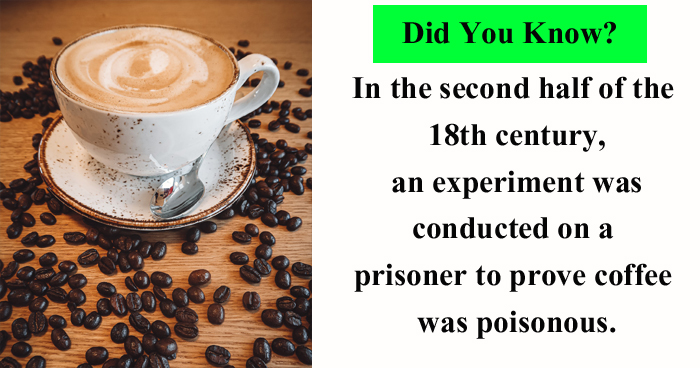
7 Truly Odd Historical Facts That I Had A Hard Time Believing Were Real
Here we have collected some interesting and strange historical facts which increase your curiosity in knowing history:-
1. An unusual psychiatric disorder is known as Glass Delusion swept across Europe during the late Middle Ages and early modern period (15th to 17th centuries), and it consisted of people coming to believe that they were made of glass and feared that they might break into pieces. King Charles VI of France suffered from a Glass Delusion. He refused to let people touch him, and he wore reinforced clothes to protect himself from accidental "shattering".
2. In 1896, New York passed the Raines Act to reduce Sunday drinking. There was a loophole in the law that allowed bars to serve alcohol with a meal. The intention behind the law was to restrict the working class’s access to drink by closing establishments on their only day off (few workers could afford a costly restaurant meal). But human ingenuity can be more powerful than any law. Bars quickly responded to this law by creating cheap, throw away sandwiches that would be known as Raines Sandwich. At first, the Raines Sandwich was two pieces of stale bread with a low-cost filler. Later, the filler was replaced with reusable rubber, and finally, the whole sandwich became reusable.
3. In 1825, a painter named Samuel Morse received a letter that his wife was sick. The next day, he got another one that said she was dead. Then when he went there, he discovered that she had already been buried. He was so mad at the slow messages, and distraught at the death of his wife, that he decided that we needed a faster method of communication, and he invented one. He called it the "Morse Code". Morse Code is a detailed system of dots, dashes, and spaces used to represent alphabet numbers, punctuation, and letters. It is used both as a code and as a way to communicate without the ability or need to use the actual characters.
4. King Gustav III of Sweden hated coffee so much that he commissioned an experiment to prove that the coffee was dangerous or poisonous beverage. He found two convicted prisoners on whom to conduct his experiment. One of them had to drink three pots of coffee every day; the other was given an equal amount of tea, and Gustav also appointed two doctors to oversee them, but the experiment proved that Gustav was wrong, and both doctors and the king died before the prisoner.
5. Ancient Egyptians had a pregnancy test where women would urinate on barley and wheat seeds. If the seed sprouted, it was said that she was pregnant. While this may sound like pseudoscience, but several modern studies have shown that it works pretty well, correctly identifying 70-85 percent of pregnancy.
6. In 1504, Christopher Columbus was stranded in Jamaica with a native who refused to give him food. But he knew the date and time of the coming lunar eclipse. So he told the natives that his gods were angry at their treatment of him, and that he would give a clear sign of displeasure by making the rising full Moon appear "inflamed with wrath". Once the eclipse had begun, the native raced to give food and begged for mercy.
7. People in Medieval times accused of a crime could opt for a "trial by ordeal". There were two main forms of ordeal-fire and the water-the result of which God was seen as determining guilt.
To fire, the accused had to carry a red-hot iron bar and walk 9ft (3m). If the wound was cleanly healed within three days, they would be innocent. But if it feasts, it's guilty.
With water, the defendant was plunged into a pool of cold water on a rope that had, a knot tied in it a "long hair length" away from the defendant. If they had sunk to the depth of the knot, the water was considered to have accepted them at God's behest. Therefore, they were innocent and dragged out before they drowned. But if they floated, the water rejected them, making them guilty.
Did you find this post interesting? Share this post with others.

Nice stuff, well written, I will have to ask for your authorization to reference two or three of your findings. Great stuff anyways.
ReplyDelete